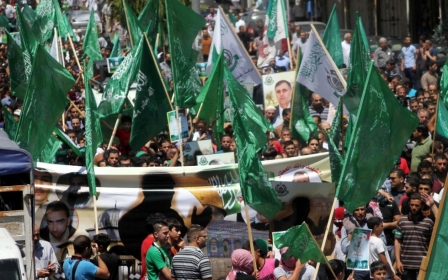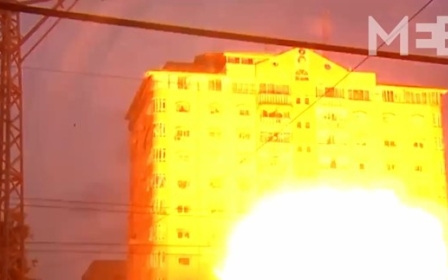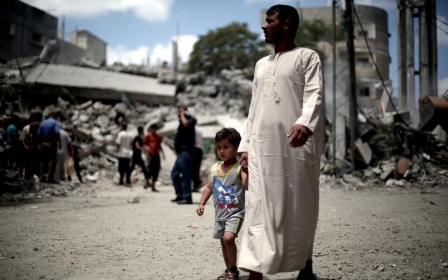‘War on Towers’: Israel’s Latest Strategy in Gaza

Palestinians in Gaza already have a name for Israel’s latest military strategy of targeting Gaza’s high-rises: “The War on Towers.” Israeli strikes on Tuesday brought down the entire Basha Tower, a 15-storey building that houses dozens of families, offices and shops.
A 16-storey complex known as ‘Little Italy’ was also struck, and was left severely damaged. 25 people were reportedly wounded in the attack. The multi-purpose tower housed many families and is located in the Nasser neighbourhood, a relatively well-to-do area in northern Gaza city.
Earlier on Tuesday, two men were killed in an Israeli strike targeting the al-Nafaq neighbourhood. In the 50th day of war in Gaza, the mostly civilian death toll stood at 2,136, according to estimates obtained by Agency France Press. Palestinians say more bodies are yet to be pulled out from underneath the rubble of destroyed homes and buildings. 68 Israelis were also killed during the same period, 64 of whom are members of the Israeli army.
After seven weeks of fighting, Israel’s targets in Gaza have now been stretched to reach Gaza’s high-risers, most of which were constructed following the establishment of the Palestinian Authority (PA) in 1994. The towers were meant to tackle a suffocating housing crisis in Gaza where thousands of exiled Palestinians lived. The Strip is home to 1.8 million people, mostly refugees, and is considered one of the most crowded regions in the world.
Aside from confronting housing problems due to the limited space in the 360 km region, the towers eventually became home to many middle class families with stable income. This privilege was often enjoyed by those who work for the PA, or belong to Gaza’s ever-shrinking business class.
The Israeli siege on Gaza was imposed shortly after the Islamic resistance movement Hamas won democratic elections in the occupied territories in January 2006, and was tightened in the summer of 2007 when Hamas and its largest rival Fatah clashed in a brief but consequential civil war. Following the crisis, Egypt sealed the Rafah border, blocking any trade movement with the already impoverished Gaza.
Within months, Gazans went underground, digging tunnels that allowed them to engage in trade, although illegally, with their Egyptian counterparts. Gaza’s economy was given a faint jolt, enough to survive, but not to thrive.
However, when current Egyptian president General Abdul Fatah al-Sisi overthrew the democratically-elected Mohammed Mori on 3 July last year, Egypt began the systematic destruction of hundreds of Gaza’s tunnels. Consequentially, the Gazan economy was reduced to a most miserable state since the advent of the siege.
Since the early days of Israel’s ‘Operation Protective Edge,’ Israel seemed to lack clear military targets belonging to the various Palestinian factions that collectively constitute the resistance. Instead, civilian areas have been targeted as thousands of homes have been destroyed. Schools, hospitals, mosques, factories and other civilian sites were also hit.
Israel claims that it has no option but to target areas where militants are hiding or using civilians as human shields, a claim that was rejected by the resistance and not substantiated by independent observers.
But attacks on high-risers could indicate a shift in Israeli tactics. “In the past, the military has hit targets in high-rises in pinpoint strikes, but left the buildings standing,” the Associated Press reported. “Since Saturday, it has toppled or destroyed five towers and shopping complexes in an apparent new tactic aimed at increasing pressure on Hamas.”
The recent attacks on commercial and residential towers, however, is being understood by analysts in an entirely different context to that offered in Israel. It is a war on the Gaza economy, they say.
According to the UN's Food and Agriculture Organisation (FAO), “about 42,000 acres of croplands had sustained substantial direct damage and half of Gaza's poultry stock had been lost due to direct hits or lack of care due to reduced access to farmlands in border areas,” reported Gaza-based journalist Mohammed Omer for Middle East Eye in Gaza. Gaza’s fishermen were also greatly harmed by Israeli restrictions and wars.
The economy seems to be a main target of the current war, according to Omer. “All this on top of the destruction of Gaza's infrastructure, including water and electricity supplies. At least 360 factories and workshops have been damaged, including 126 that were completely wrecked, amounting to $47 million in damages.”
Some say that adding the towers to the growing cost is in line with that logic. With their destruction, Israel is hoping to place more pressure on Hamas, to increase the price for its resistance, but also create a housing crisis that cannot be easily resolved, even if the siege were to be lifted.
The recent shift in Israel’s list of targets comes at a time that Egypt has called on both Israel and Hamas to reach a ‘permanent’ ceasefire, where issues pertaining to the sea and airport are to be postponed for another month. With thousands more now finding themselves homeless, Hamas is under immense pressure to deal with the burgeoning crisis, while refusing to heed to Israeli demands or Egypt’s mediation.
Ultimately, the “The War on Towers” might not have a major impact on the direction of the Gaza war. But with thousands of people fleeing their homes in panic amid scenes of collapsed high-risers, the humanitarian situation in Gaza is at a catastrophic state, as is the state of its economy.
New MEE newsletter: Jerusalem Dispatch
Sign up to get the latest insights and analysis on Israel-Palestine, alongside Turkey Unpacked and other MEE newsletters
Middle East Eye delivers independent and unrivalled coverage and analysis of the Middle East, North Africa and beyond. To learn more about republishing this content and the associated fees, please fill out this form. More about MEE can be found here.




